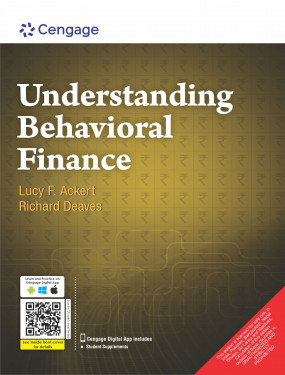
eBook for Understanding Behavioral Finance
ISBN: 9789355730893
Higher Education

Author(s): Lucy Ackert
ISBN: 9788131515440
1st Edition
Copyright: 2011
India Release: 2011
Binding: Paperback
Pages: 348
Trim Size: 241 X 181 mm
This comprehensive textideal for today's behavioral finance electivelinks finance theory and practice to human behavior. The book begins by building upon the established, conventional principles of finance before moving into psychological principles of behavioral finance, including heuristics and biases, overconfidence, emotion and social forces. Readers learn how human behavior influences the decisions of individual investors and professional finance practitioners, managers, and markets. The book clearly explains what behavioral finance indicates about observed market outcomes as well as how psychological biases potentially impact the behavior of managers. Readers utilize theory and applications in every chapter with a wide variety of end-of-chapter exercises, discussion questions, simulations and experiments that reinforce the book's applied approach.
PART I: Conventional finance, prospect theory, and market efficiency.
Chapter 1: Foundations of Finance I: Expected Utility Theory.
Chapter 2: Foundations of Finance II: Asset Pricing, Market Efficiency, Agency Relationships.
Chapter 3: Prospect Theory, Framing and Mental Accounting.
Chapter 4: Challenges to Market Efficiency.
PART II: Behavioral Science Foundations.
Chapter 5: Heuristics and biases.
Chapter 6: Overconfidence.
Chapter 7: Emotional Foundations.
PART III: Investor Behavior.
Chapter 8: Implications of Heuristics and Biases for Financial Decision- Making.
Chapter 9: Implications of Overconfidence for Financial Decision-Making .
Chapter 10: Individual Investors and the Force of Emotion.
PART IV: Social Forces.
Chapter 11: Social forces: Selfishness or Altruism?
Chapter 12: Social forces and Work: The Collapse of an American Corporation.
PART V: Market Outcomes.
Chapter 13: Behavioral Explanations for Anomalies.
Chapter 14: Do Behavioral Factors Explain Stock Market Puzzles?
PART VI: Corporate Finance.
Chapter 15: Rational Managers and Irrational Investors.
Chapter 16: Behavioral Corporate Finance and Managerial Decision-Making.
PART VII: Retirement, Pensions, Education, Debiasing and Client Management.
Chapter 17: Understanding Retirement Saving and Investment Behavior and Improving DC Pensions.
Chapter 18: Debiasing, Education, and Client Management.
PART VIII: Money Management.
Chapter 19: Behavioral Investing.
Chapter 20: Neurofinance and trader’s Brain.
Lucy Ackert; Kennesaw State University
Richard Deaves; McMaster University